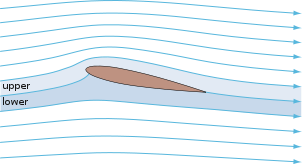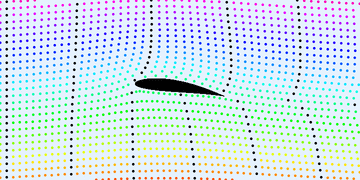Basic function of an airfoil
Lift is defined as the force perpendicular to the direction of the air flow, and is responsible for negating gravity and thus making an airplane or helicopter fly. Lift is the result of 2 different factors. The first factor is quite obvious: an airfoil changes the direction of the airflow downwards, this is known as downwash.
The second factor is caused by pressure differences. When air hits the front of the airfoil, the airflow is split in two. Because of the angle of attack, the air below the wing is compressed, and the air flowing above the wing, flows well over the surface of the wing, in an arc shape. The air closest to the upper surface is traveling slower than the air above it, and this creates a low pressure pocket because of the Bernouilli effect.
It is possible to fly with a completely flat wing, but most wings have a typical airfoil shape which helps the air arc over the upper surface. Helicopter blades do not have a pronounced airfoil shape because drag is of less concern, but they use the same mechanics to produce a lifting force.
Sources:
http://warp.povusers.org/grrr/airfoilmyth.html
http://en.wikipedia.org/wiki/Airfoil
http://en.wikipedia.org/wiki/Lift_(force)
Subscribe to:
Post Comments (Atom)



0 comments:
Post a Comment